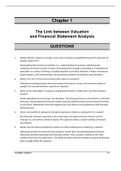Examen
Test Bank for Valuation Using Financial Statements, 2nd Edition by Sommers
- Cours
- Établissement
Test Bank for Valuation Using Financial Statements 2e 2nd Edition by Sommers, Easton, Drake. ISBN-13: 3630 Full Chapters test bank included Chapter One: The Link between Valuation and Financial Statement Analysis (pg. 1.1) Chapter Two: Role of Accounting (pg. 2.1) Chapter Three: Refor...
[Montrer plus]




